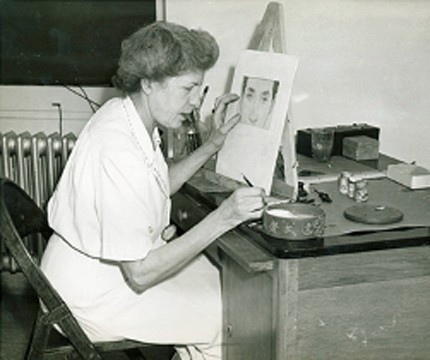Mildred G. Burrage, 1890 – 1983
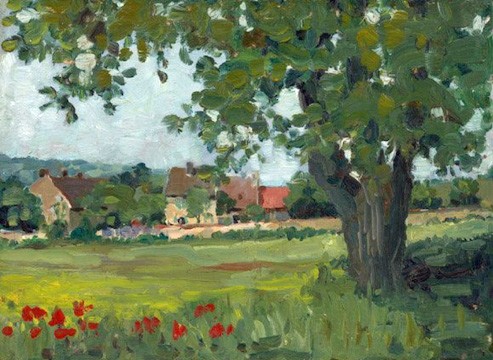
Mildred Giddings Burrage was born in Portland, Maine in 1890 to Henry S. Burrage (who would eventually become the first Maine State Historian) and his second wife, Ernestine Maie Giddings. Ernestine was the daughter of a wealthy Bangor, Maine industrialist and a talented artist in her own right. At an early age, Mildred demonstrated her gift for drawing and painting, and her parents fostered her talent by enrolling her in various art classes. Her formal education, which would ultimately bring her to France, began in 1908 at the Wheeler School in Providence, Rhode Island, when she was eighteen years old. One year later, Mary Colman Wheeler invited Mildred and several of her classmates to paint that summer at Giverny, where she had established a school of painting in the “Hameau.” Young American women painted "en plein air" and practiced drawing with live models at this school. Burrage returned to Giverny in the summer of 1910 and decided to stay in France to pursue her studies. She also taught at the Wheeler school between 1911 and 1912.
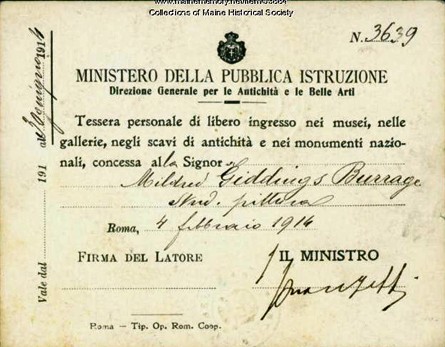
Her first Giverny experience marked the beginning of several extended stays in France between 1909 and 1912, including several months in Paris. Burrage also spent a year in Rome from 1913 to 1914. Each of these European sojourns formed the basis of her long artistic career, which lasted nearly seventy years. In France, Burrage came into contact with Claude Monet and with numerous American artists, such as Frederick Carl Frieseke, Richard E. Miller (who became her mentor and friend in 1908), Lawton S. Parker, Guy Rose, Edmund Greacen, Frederick MacMonnies, and Karl Anderson. Burrage also visited museums, galleries, and exhibits in Paris and other parts of Europe. She was especially moved by the paintings of Matisse at the 1910 Salon d'Automne.
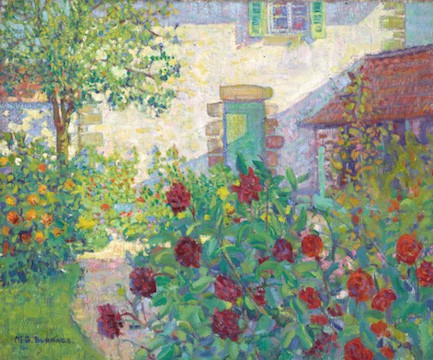
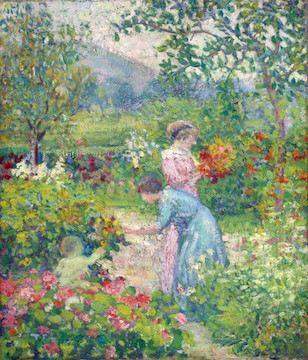
According to Earle G. Shettleworth, Jr., “On October 15 [1910] she moved into her room at the American Art Students Club [sic] at 4 rue de Chevreuse in Paris, near the Luxembourg Gardens, where she would live for the next eight months” (2012, n.p.). Like so many other residents at the Club, she was enrolled at the Académie de la Grande Chaumière (working under Lucien Simon) and at the Académie Colarossi (studying with Henri Caro-Delvaille). She also continued her training with Richard E. Miller at his Paris studio. During this period, she painted flowers, gardens, and landscapes. Burrage exhibited her paintings not only at the Club and in the 1911 Salon des Indépendants, but also at the Salon d'Automne (1912), the Pennsylvania Academy of Fine Arts (1911, 1913), and The Art Institute of Chicago (1913). Burrage was awarded the Whitney Hoff prize for her painting “Le Bourg,” shown at the International Art Union Exhibit of 1912.
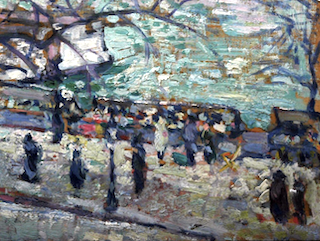
The significance of her formative years in Europe was evident in a 2012 exhibit at the Portland Museum of Art, "From Portland to Paris: Mildred Burrage's Years in France," with over 70 of her works on display. According to museum curators, it reflected “a unique time of innocence, ebullience, and optimism in Mildred Burrage’s life and career, and in the American and European psyche before the onset of the First World War” (cited in Shettleworth, 2012, n.p.). In the catalog accompanying the exhibit, Shettleworth, Jr. remarked: "For Mildred Burrage, the years from 1909 – 1914 were the cornerstones of a long, extraordinary life devoted to pursuing new ways of expressing herself through art (quoted in the Sun Journal, June 17, 2012, n.p.).
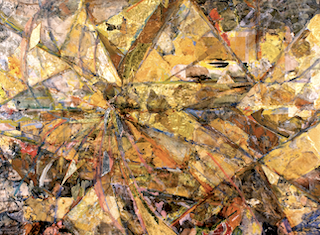
The outbreak of World War I forced Mildred to return to Maine, where she continued to paint and write. She lived with her sister Madeleine (called “Bob”), a jeweler and gemologist, in Kennebunkport for nearly thirty years, from 1917 – 1947. As Burrage evolved artistically, she moved away from the Impressionism of her youth and toward Abstract Expressionism, including collages made from mica, which she fabricated later in life (such collages can be found in the collection of the Farnsworth Art Museum and the Colby College Museum). In her post-war years, Burrage, who was influenced by Jackson Pollock, began to paint increasingly abstract and unique mica collages: “After attaching mica, foil, and paper to a panel, she would paint abstractly on the surface of the collage” (Shettleworth, 2016, 34). She exhibited several of these “Maine Mica Pictures” at the Jesup Memorial Library in Bar Harbor in July, 1933 (ibid.).
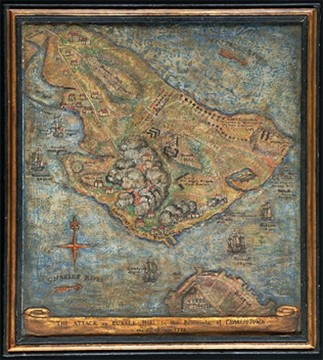
For a period in the 1920s, Burrage was inspired by American cartography and history. She executed a number of relief paintings based on historic prints, maps, and engravings, having revived the ancient method of Italian gesso. First Lady Lou Henry Hoover attended the 1929 opening of the exhibition of Burrage's maps at the Dunthorne Gallery in Washington (“Mrs. Hoover Sees Unique Maps [...]”). One such relief painting depicted the Battle of Bunker Hill and was likely derived from a 1775 vignette by Sayer and Bennett. It is owned by the Norman B. Leventhal Map & Education Center at the Boston Public Library.
During the Great Depression, Burrage joined the ranks of so many other American artists who actively participated in the efforts of the Works Project Administration (WPA). Her projects included two murals for Bryn Mawr College’s new science library (ca. 1940), and, with FDR’s uncle, Frederick A. Delano, a handkerchief map of Washington, D.C. based on a 1792 map.
From 1931 – 1936, Mildred and her sister traveled in the American Southwest, Mexico, and Guatemala. Madeleine collected stones for her jewelry while her sister painted landscapes, marketplaces, and people. Their work was shown in several galleries in Maine, New York, and Chicago (Shettleworth, Jr. 1962, 28-29).
Mildred served her country during WWII, volunteering in Staten Island, New York at the Halloran General Hospital, where she and her sister taught art to wounded soldiers from 1944 – 1945, through the arts and skills program subsidized by the American Red Cross. The program, which began in February 1943 in several New York hospitals, trained convalescing army and naval veterans in the making of handicrafts, which they could keep or sell. While at Halloran, Burrage also worked as a medical illustrator, depicting the eye and facial injuries of several wounded soldiers. Many of her drawings and watercolors from this time at Halloran are now in the Otis Historical Archives of the National Museum of Health and Medicine.
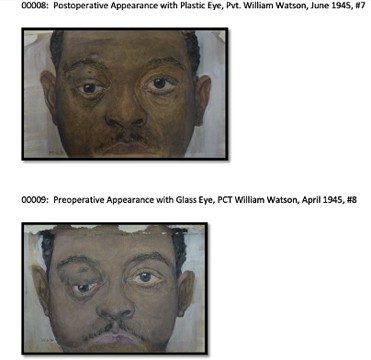
Burrage became active as a preservationist in the last decades of her life. In 1954, she established the Lincoln County Historical Association and she served a term as Director of the National Trust for Historic Preservation. Mildred and Madeleine moved to Wiscasset, Maine in 1947, remaining there for the rest of their lives, with Mildred founding the Maine Art Gallery in Wiscasset in 1957. Among its early board members were Marguerite Thompson Zorach, a fellow Girls’ Art Club alumna, as well as Zorach’s daughter, painter Dahlov Ipcar.
Today, Mildred Burrage is recognized as one of Maine's premier women artists. Her papers can be found at the Maine Women Writers Collection of the University of New England. Mildred and Madeleine were each awarded honorary Master of Arts degrees by Colby College in 1963 ("Madeline Burrage Dead; Maine Gemologist Was 84"). An extensive collection of Mildred’s artworks and Madeleine’s jewelry can be viewed on the Portland Museum of Art’s website.
In 2016, Burrage's friend, Earle G. Shettleworth, Jr., and Sally W. Rand curated an exhibition that traced her 65-year career at the University of New England Art Gallery. This retrospective included landscapes, seascapes, portraits, patriotic posters, historic maps, flora of the Southwest and Central America, and images of World War II shipbuilding.
According to the Maine Historical Society:
After her death in 1983, the Portland Museum of Art acquired the art studio and personal papers of Mildred Giddings Burrage. The PMA intended to de-accession and transfer the archival materials to the Smithsonian’s Archives of American Art when members of the public requested the materials stay within Maine. Mildred’s father, Henry Sweeter Burrage, had a long standing relationship with the Maine Historical Society therefore MHS was deemed a logical repository for Ms. Burrage's collection.
As of August 2023 the finding aid is no longer accessible and it appears the collection has been deaccessioned.
Sources
- “Arts and Skills To Be Taught Convalescents.” The Daily Mail, January 26, 1943, p. 5. Newspapers.com
- Beem, Edgar Allen. “Mildred Burrage Goes to France.” New England Today, April 25, 2012.
- Brennan, Jan. "Dilettante: Last chance to see 'Mildred Burrage' at the PMA." The New Maine Times, June 27, 2012.
- Burrage, Mildred Giddings. "Art and Artists at Giverny." World Today, vol. 20, no. 3, March 1911. pp. 344-351. Google Books.
- Burrage, Mildred G. "The attack on Bunker Hill in the peninsula of Charlestown the 17th of June 1775." Map. 1926. Norman B. Leventhal Map & Education Center.
- Finding Aid for Maine Historical Society Coll. 2494, Mildred Giddings Burrage (1890-1983) Collection. *As of August 2023 the finding aid is no longer accessible and it appears the collection has been deaccessioned.*
- Finding Aid for OHA 229 Medical Illustration Collection, Otis Historical Archives, National Museum of Health and Medicine, Series III Post-World War I Illustration, Box 023: Mildred G. Burrage, Halloran General Hospital, pp.166-172.
- Gephart, Kathryn B. Ellen Anderson, Mildred Burrage, and the Errancy of Modernist Painting. MA Thesis, University of Cincinnati, 2013.
- Heller, Jules and Nancy G. Heller, “Burrage, Mildred Giddigns (1890-1983).” North American Women Artists of the Twentieth Century: A Biographical Dictionary. New York: Routledge, 1995, p.100.
- “International Art Union Gives a Fine Exhibition.” The New York Herald (European Edition), November 17, 1912, p. 3. International Herald Tribune Historical Archives.
- Keyes, Bob. "Plein to see." Portland Press Herald, April 19, 2012.
- "Madeline Burrage Dead; Maine Gemologist Was 84." New York Times, July 28, 1976, p.27.
- Maine Art Gallery Wiscasset.
- Mica collages by Mildred G. Burrage at the Farnsworth Art Museum.
- "'Portland to Paris': Portland Museum of Art showing works painted by Mainer Mildred Burrage while overseas." Sun Journal, Lewiston, Me., June 17, 2012.
- Shettleworth, Earle G., Jr.. "The Making of an Artist: Mildred G. Burrage's Early Years." Republished in Resource Library, May 14, 2012.
- Shettleworth, Earle G., Jr. The Art Of Mildred G. Burrage: Exhibition Catalogue. University of New England Art Gallery, March 2016.
- Special from the Monitor Bureau. "Mrs. Hoover Sees Unique Maps Done in Ancient Style: Attends Painting Exhibition in Washington where Old Italian Style is Used." The Christian Science Monitor, March 19, 1929, p. 2. ProQuest Historical Newspapers.
